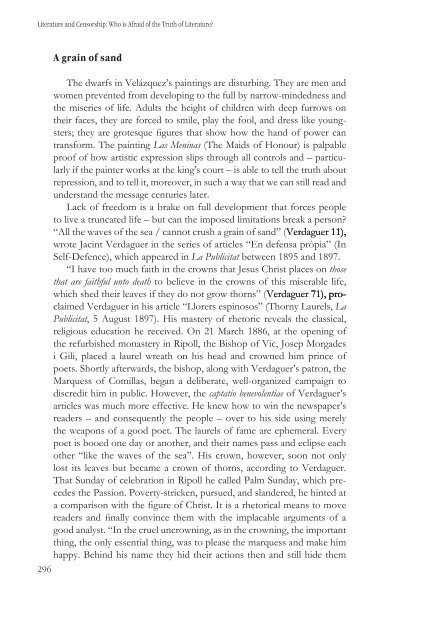Literatura in cenzura - Društvo za primerjalno književnost - ZRC SAZU
Literatura in cenzura - Društvo za primerjalno književnost - ZRC SAZU
Literatura in cenzura - Društvo za primerjalno književnost - ZRC SAZU
- No tags were found...
You also want an ePaper? Increase the reach of your titles
YUMPU automatically turns print PDFs into web optimized ePapers that Google loves.
Literature and Censorship: Who is Afraid of the Truth of Literature?296A gra<strong>in</strong> of sandThe dwarfs <strong>in</strong> Velázquez’s pa<strong>in</strong>t<strong>in</strong>gs are disturb<strong>in</strong>g. They are men andwomen prevented from develop<strong>in</strong>g to the full by narrow-m<strong>in</strong>dedness andthe miseries of life. Adults the height of children with deep furrows ontheir faces, they are forced to smile, play the fool, and dress like youngsters;they are grotesque figures that show how the hand of power cantransform. The pa<strong>in</strong>t<strong>in</strong>g Las Men<strong>in</strong>as (The Maids of Honour) is palpableproof of how artistic expression slips through all controls and – particularlyif the pa<strong>in</strong>ter works at the k<strong>in</strong>g’s court – is able to tell the truth aboutrepression, and to tell it, moreover, <strong>in</strong> such a way that we can still read andunderstand the message centuries later.Lack of freedom is a brake on full development that forces peopleto live a truncated life – but can the imposed limitations break a person?“All the waves of the sea / cannot crush a gra<strong>in</strong> of sand” (Verdaguer 11),wrote Jac<strong>in</strong>t Verdaguer <strong>in</strong> the series of articles “En defensa pròpia” (InSelf-Defence), which appeared <strong>in</strong> La Publicitat between 1895 and 1897.“I have too much faith <strong>in</strong> the crowns that Jesus Christ places on thosethat are faithful unto death to believe <strong>in</strong> the crowns of this miserable life,which shed their leaves if they do not grow thorns” (Verdaguer 71), proclaimedVerdaguer <strong>in</strong> his article “Llorers esp<strong>in</strong>osos” (Thorny Laurels, LaproPublicitat, 5 August 1897). His mastery of rhetoric reveals the classical,religious education he received. On 21 March 1886, at the open<strong>in</strong>g ofthe refurbished monastery <strong>in</strong> Ripoll, the Bishop of Vic, Josep Morgadesi Gili, placed a laurel wreath on his head and crowned him pr<strong>in</strong>ce ofpoets. Shortly afterwards, the bishop, along with Verdaguer’s patron, theMarquess of Comillas, began a deliberate, well-organized campaign todiscredit him <strong>in</strong> public. However, the captatio benevolentiae of Verdaguer’sarticles was much more effective. He knew how to w<strong>in</strong> the newspaper’sreaders – and consequently the people – over to his side us<strong>in</strong>g merelythe weapons of a good poet. The laurels of fame are ephemeral. Everypoet is booed one day or another, and their names pass and eclipse eachother “like the waves of the sea”. His crown, however, soon not onlylost its leaves but became a crown of thorns, accord<strong>in</strong>g to Verdaguer.That Sunday of celebration <strong>in</strong> Ripoll he called Palm Sunday, which precedesthe Passion. Poverty-stricken, pursued, and slandered, he h<strong>in</strong>ted ata comparison with the figure of Christ. It is a rhetorical means to movereaders and f<strong>in</strong>ally conv<strong>in</strong>ce them with the implacable arguments of agood analyst. “In the cruel uncrown<strong>in</strong>g, as <strong>in</strong> the crown<strong>in</strong>g, the importantth<strong>in</strong>g, the only essential th<strong>in</strong>g, was to please the marquess and make himhappy. Beh<strong>in</strong>d his name they hid their actions then and still hide them
















